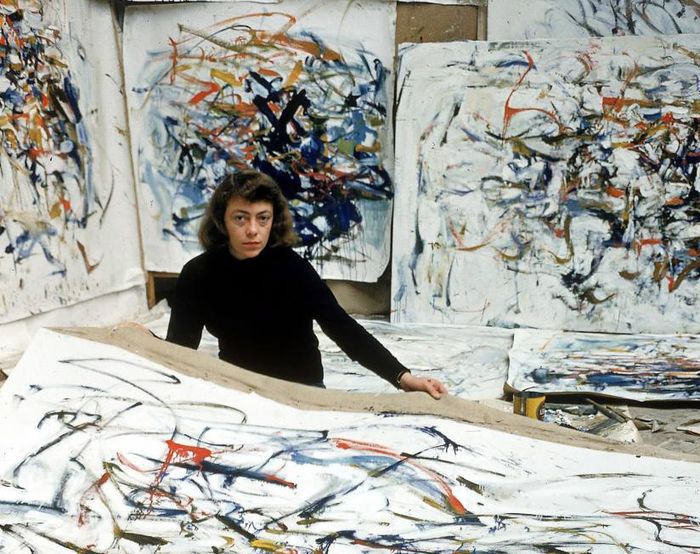February 12 is the birthday of Abstract Expressionist painter Joan Mitchell (1925-1992).
Everything about Mitchell’s privileged early life and academic career might have suggested a smooth path to an early successful career as an artist. Born into a wealthy family (her father was a physician; her mother, co-editor of Poetry magazine.), she was financially independent, and was educated at the Art Institute of Chicago. When she moved to New York in 1949, she was invited to be a member of the “Artists’ Club,” an honor extended to very few women, and exhibited her work in their show in 1951. By that time, Mitchell was working in the same “action painting” style and moving in the same circles as the “major” Abstract Expressionists. However, she and other female Ab Ex painters at the time came to be labeled “second generation,” and relegated to a lesser status.
“Mitchell was undervalued by being called second generation,” said Crystal Bridges board member Don Bacigalupi. “That phrase is really loaded, because it suggests that she came after and copied what came before her, in the pioneering generation of male artists. She didn’t. She was right there with them, the same generation, the same accomplishment… but “second generation’ was an perhaps a more politic way of saying “second class” because of her gender. Neither she nor any of the female Ab Ex artists were included in the canon of that first generation.”
Mitchell was well aware of the true meaning of “second generation,” but she largely shrugged it off and just kept painting. She was outspoken, unpredictable, profane, and tough. Fellow artist Grace Hartigan, who met her for the first time in New York in the early 50s, said of her “I’ve never heard anyone swear like that—male or female.” And the author Jane Livingstone, who helped organize an exhibition of her work at the Corcoran Gallery in 1981 said, “frankly, she frightened me.”
Perhaps it was this toughness that allowed Mitchell to eventually succeed. Maybe it was the fact that she always considered herself an outsider to the art world. She divided her time between New York and Paris, and she moved permanently to France in 1959, which allowed her some distance, both emotionally and physically, from the competitive New York art scene. “My relationship with the art world is distant, and occurs mainly through individuals,” Mitchell once said. “As I love painting, I go to galleries, museums, to artists’ homes, but the art world has never really interested me.”
Mitchell gradually developed her own unique style that combined the gestural “action painting” of the “first generation” Ab Ex painters with the color and sense of figure and ground she had gleaned from Matisse and van Gogh. She referenced landscapes and natural elements in a way most of the “first generation” artists had not. Her work was vigorous, but she never painted willy-nilly, expressing instead an appreciation for “paint well put on, felt, applied with a reason.”
While she garnered critical acclaim as early as the 1950s, both in the US and in Europe, by the 1970s, critics were praising her work while wondering at her lack of recognition. She did not get her first solo museum exhibition until 1972, at the Everson Museum of Art, Syracuse, New York.
On Sunday, March 15, Patricia Albers, author of Joan Mitchell, Lady Painter: A Life will present a Spotlight Lecture that brilliantly reconstructs Mitchell’s large and impassioned life: her growing prominence as an artist; her marriage and affairs; her friendships with poets and painters; and her extraordinary work.






